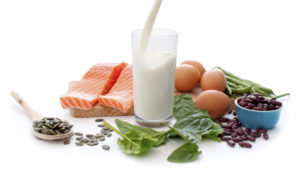
Sorry, gym-bros – all those end-of-workout sprints to slip through the anabolic window (the period of time after training when the body builds muscle) like Indiana Jones escaping a temple were probably a waste of time. That’s the bad news, but here’s the good part: as the most-researched macronutrient on the planet, protein has never been better understood, and that means you’re perfectly positioned to recalibrate your intake by simply understanding the basics. Read on, and never let another scoop of whey go to waste
Have protein pre-workout
Firstly, there’s evidence it helps protein synthesis: according to that metaanalysis, the window is influenced more by your pre-training meal than the workout. Timing pre- and post-exercise intake to be within four hours of each other had a bigger effect than worrying about banging down a whey shake within 20 minutes of leaving the squat rack. Secondly, it might help fat loss: in a study where subjects took in 18g of whey protein or carbs before heavy lifting, resting energy expenditure was jacked up an extra 5% over the baseline for up to 24 hours – equal to about 90 cals, or more than what some thermogenic supps burn off. So get a hit of protein an hour before training, another one afterwards, and keep your intake up the rest of the day. How high? Glad you asked…
Athletes need more
Right now, the NHS-recommended protein intake is 50g a day: not bad, but it could be better. That amount will keep you healthy, but if you’re physically active, injured, ageing or otherwise in need of repair, more might help. Studies have been done on a huge variety of intakes, but the consensus from scientists at the 2010 IOC Conference on Nutrition in Sport is that an intake of 1.3-1.8g per kg of body weight per day is ideal. Is there an upper limit? Definitely, but it’s not well-established: in clinical studies, eating up to 4.4g per kilo of body weight (so around 330g a day for an average-sized man) didn’t cause any short-term health problems. And don’t think that just because you’re a runner (or cyclist) your needs are lower: endurance workouts also stimulate protein synthesis. According to a study from Ball State University, USA, protein synthesis increased around 50% in the hours immediately following a 60-minute bike ride. It all helps recovery
Look for the L-word
There are nine essential amino acids – those your body can’t synthesise from scratch – but this is no time to develop a niche favourite like phenylalanine. The one you want to worry about is leucine, which is one of three BCAAs that aren’t degraded by enzymes in the liver. An everexpanding body of research suggests it’s the key to whey’s muscle-building properties, but that’s not all: in at least one double-blind trial, leucine raised time-to-exhaustion in a high-intensity row, reducing the rate of perceived exertion and improving upper body power compared to a placebo group. Less convincingly, but worth noting, is that in animal studies, rodents given leucine during a calorierestricted diet showed less muscle wastage than their protein-deprived brethren. You’ll get leucine from whey, but you can also top up with a dedicated powder – or just up your dairy and meat intake.
Plants are important
It’s technically true that plants contain incomplete proteins – or ones that only contain part of the full range of amino acids essential to life and muscular recovery – but that doesn’t necessarily mean that fuelling with lentils is worse than scarfing down a steak. A few years ago, you’d have been told that it was necessary to eat a variety of plants at every meal to get a complete range of amino acids, but now it’s accepted that just making sure you get a variety throughout the day/week is enough. There’s also evidence that going plant-based for at least some of your intake has more health benefits than sticking with steak. There are confounding factors – no large-scale studies have compared seafood to cows yet, for instance – but eating some plant-based protein is a good idea even for hard-core carnivores. Top up with asparagus and sweet potatoes, or dip your celery and carrot sticks into houmous. Alternatively, add rice, hemp or pea proteins to meals.
This move is king when it comes to core. Learn perfect form to reap maximum benefits and avoid injury.
The bounce back begins. There’s no doubt that the Covid-19 crisis curtailed fitness routines for millions, as competitions were cancelled, training programmes postponed and events put on […]



